
Following the collapse of the Menzies Government and Arthur Fadden's forty days as Australia's leader, John Curtin became Prime Minister when two Independent members, Coles and Wilson, gave Labor a majority in the House of Representatives.
Personal glimpses of the PM in the press . . .
The press reported the Prime Minister as a man of few pretensions.
In Perth it is just, 'Good morning, Mr Curtin,' in a very friendly fashion, but without the feeling of basking in the reflected glory of a prime minister that other States appear to have when the prime minister is a native son. 1
Unworried, unconcerned about clothes rationing as it will affect his wardrobe is Prime Minister John Curtin, who has never been a fancy dresser, who likes his old clothes. . . .
Curtin never wears coloured shirts – always white with a stiff colour and plain ties, of which he is reported to have six. He invariably wears dark-coloured socks of the well-known variety that have red-lettering across the top.
For Mrs Curtin it looked like more darning for the duration. 2

Working in the Prime Minister's office
A few weeks into his prime ministership, John Curtin wrote to the Public Service Commissioner to clarify the details of employment of his personal staff. He noted that the private secretarial work was divided between Mr Tonkin, Private Secretary (Personal) and Mr McLaughlin, Private Secretary (Departmental) and that 'Misses Lenihan, Craig and Joyce are the subordinate staff who assist the Private Secretaries in the general office work, filing and typing'. 3
In reply, the Commissioner, Mr F G Thorpe, granted salary increases to Mr Tonkin and Mr McLaughlin because of their additional duties and responsibilities but noted that 'the rates being paid Misses Lenihan, Craig and Joyce are thought to be appropriate to their present duties'. 4
Eventually, Eileen Lenihan chose to stay as personal secretary to Robert Menzies and left the Prime Minister's Department.
First thing in the morning secretarial staff would sort the mail, which on occasions was particularly voluminous, sometimes ‘odd’ and even abusive. Staff would deal with what they could and pass the rest on for an appropriate person to respond. Many would be from people wanting to secure the release of their sons from the forces, and these were referred to the relevant Minister. 5
Prime Minister John Curtin
John Curtin Prime Ministerial Library. Records of the Government Photographic
Service. Rt Hon John Curtin (1885-1945) Prime Minister 1941-1945. JCPML00036/13
Letter from PM Curtin to Public Services Commission, 4 November 1941. National Archives of Australia: A5954, 689/12
Letter from F G Thorpe, Commissioner, to PM Curtin, 10 November 1941. National Archives of Australia: A5954, 689/12
Eric Tonkin, Private Secretary (Personal)
Eric Tonkin, used to handle political material, replying on the Prime Minister's behalf to correspondents writing on a wide range of matters. For example, he replied to a letter from Mr Macartney Abbott, who wrote to Curtin during the 1943 election campaign. Mr Abbot wrote:
I am convinced that we can have no satisfactory solution of either global security or social security which are bound up in world wide financial considerations without the greatest measure of International Co-operation that we are able to obtain in the Post War world. . . . In this period, Mr Evatt's, as also your own presence in Parliament will be essential. . . . I would be glad to do what I may to keep Dr Evatt in his seat. 6
Eric Tonkin wrote in reply:
Prior to leaving for Melbourne Mr. Curtin asked me to drop you a note and convey to you his sincere thanks for your offer of assistance. The Prime Minister very much appreciates your remarks and is pleased to know that you intend to help Dr. Evatt retain his seat. 7
Letters that had ‘a real official touch to them’ would go straight across to the Prime Minister’s Department, however these were returned if the Department considered they required the Prime Minister’s attention. 8
Fred McLaughlin, Departmental Private Secretary
Fred McLaughlin handled departmental affairs for the Prime Minister, including dealing with correspondence relating to departmental matters from both individuals, organisations and other areas of government. For example, in January 1942, he replied on the Prime Minister's behalf to the Five Dock ALP:
The Prime Minister desires me to acknowledge the receipt of your telegram of 19 January, 1942, and to inform you that he has noted the views of your organisation regarding the appointment of the Hon. A. W. Fadden, M.P,, to make investigations in relation to matters connected with the Commonwealth Aircraft establishment at Lidcombe. 9
And in August 1943, he wrote to Mr George Adam:
With reference to your letter of 5th August, I am desired by the Prime Minister to inform you that the preference clause in the Repatriation Act only provides for granting of preference to members of the Defence Forces. . . . If this Soldiers' Act were amended to cover civilians who have suffered from infantile paralysis, it would no longer be a Soldiers' Act ... 10
Fred McLaughlin was reputed to be an important adviser to Curtin. 11 He was a meticulous man, ‘who dotted every “i” and made sure everything was done’. 12
He was also a strong supporter of the Moral Rearmament Association, a movement which called for a moral and spiritual rearmament to work towards a better world. McLaughlin’s family felt, ‘his Christian walk and his connection with moral rearmament at that time were quite significant’. McLaughlin told them he spent, ‘an awful lot of time during that war on my knees in my office,’ praying, particularly at the time of Curtin’s dispute with Churchill over the return of Australian troops, which he described as, ‘probably the most difficult night he had ever gone through’. 13
Hazel Craig, a stenographer in the Prime Minister's office, remembered Fred McLaughlin as someone who expected you ‘to do good deeds and live a better life than you were living and so he used to leave notes for us all around saying how we could make our lives better’. 14
Gladys Joyce, Secretary
Gladys Joyce worked as John Curtin’s personal secretary from 1941 until his death in 1945 and found it a very good job - Mr Curtin was ‘a wonderful man to work for, very patient’. She never saw him ‘angry or frazzled’, noting that he would not have shown exasperation in front of female members of staff, because, ‘In those days men didn’t think it was right to display anger in front of girls’. He was very thoughtful and appreciative of what staff did for him, and though reserved he had a sense of humour, and told occasional jokes. She recalled that Curtin was very tidy and his office was clutter free, though he had shelves of books. For about an hour every day he would stretch out on the couch in his room, at times staring ‘up at the ceiling with his cigarette holder jutting out from between his teeth, smoking and looking up at the ceiling and thinking through his problems’. 15
Gladys Joyce controlled the ever changing assigned staff, some of whom left to be married. (Women were required to resign their government jobs when they wished to marry at that time.) Some staff did not stay long – one started and left before lunch time, and another objected to the electric light being on and left pretty quickly also. Miss Joyce had a 'special clerical type classification' and earned approximately four to five pounds per week. 16 This was at a time when the minimum rate for adult members of the women’s services was 4 shillings and fourpence per day. 17
Proceedings of conferences would also have to be recorded manually, and also meetings and speeches at occasions such as loan rallies, which would have to be transcribed afterwards. Gladys Joyce, who had a shorthand speed of about 140 words per minute, recorded a particularly arduous three-day conference chaired by Curtin, in which he was trying to negotiate a peace between coalminers (who were threatening to strike) and coal mine owners. 18
She also had control of the telephone exchange which could be switched through to a secret phone. Sometimes Curtin asked for the call to be recorded and she would be required to take down the conversation from both sides. When a telephone call came in, office protocol demanded that the less important person wait on line until the more important person was ready to receive the call. Gladys Joyce recalls ‘jousting’ with General MacArthur’s secretary over who should be switched through first:
She wanted to put him on first. I said, “No,” I said, “I shall put the prime minister on when you’re ready.” She said, “Well shall we switch together?” She was protecting him and I was protecting my man. I thought as Prime Minister of Australia he had the priority to not have to wait until she got him on, got MacArthur on. 19
As well, there were sometimes 'other duties as required'. One time, when long-serving parliamentarian Billy Hughes came out of an Advisory War Council meeting with a button missing from his vest Gladys Joyce had to:
stand there and sew it on for him … Today I would have said, “Please take your vest off.” But I was not quite so confident in those days … I thought it was a very odd thing to expect you to sew it while he stood there. 20
Those who worked beyond the office
Chefs, waiters, cleaners, attendants, security personnel, barbers, housekeepers and gardeners were all part of the workforce that kept Parliament House functioning. Curtin was never too busy to chat informally with Parliament House attendants and his consideration also extended to those who worked beyond his office 21 from dining room staff to telephonists.
At Christmas time he used to make a special visit to the telephonist to thank her for all the calls and trouble she’d gone to for him during the year. 22
Working hours
Staff worked long hours particularly when the House was sitting, often until twelve, or one in the morning. 23 Prime Minister Curtin was ‘always noted for his capacity as a hard worker’ and finding that ‘seven days make too short a working week’, worked weekends, including Sunday, through holidays and Christmas, and frequently when he was ill. 24
A 1942 newspaper article described the Prime Minister's 'timetable for an easy day'.
Rises, 8 am. In office, 9 a.m. The morning is filled with interviewing Ministers, service chiefs, departmental heads, foreign diplomats and trade union executives until -
1.30 pm. Press conference
Lunch from time this conference ends, usually 1.45 pm, sometimes 2pm to 2.15 pm
Back in the office 2.15 pm to go through the same routine as the morning until -
6.45 pm. Press conference to 7 pm.
Dinner and current newspapers until 8 pm.
Back in office or at the Prime Minister's Lodge dealing with cables and reports until, at the earliest -
Midnight, when he tries to get to bed, reading more newspapers and something diverting, mostly thrillers. 25
Gladys Joyce lived in Forrest (a Canberra suburb) with her parents and cycled to and from work. She often had to cycle home in blackout conditions, which she found a frightening experience:
It was very onerous. We had very, very long hours … Sometimes you’d be there till midnight; sometimes I was trying to catch up with work and I’d be the only person in Parliament House. It was rather eerie going out of the building crossing King’s Hall. And I used to have a bicycle in those days. 26
Frequently during the war the last two lights left on in Parliament House would be those of the Prime Minister and Fred McLaughlin, and they would stay lit well into the early hours of the morning. Fred McLaughlin could manage on minimal sleep. ‘He could go to bed at two o’clock and wake up two hours later, and be ready to go. He knew how to cut off, go to sleep, and yet time himself to get up. He just didn’t sleep very much.’ His family remember Fred arriving home in a big black car and being picked up again to catch the train carrying his bags locked to his wrist. 27
John Curtin and Eric Tonkin (right) in 1937.
Image cropped from: John Curtin Prime Ministerial Library. Records of
the Curtin Family. Eric Tonkin, John Curtin and Don K Rodgers, Adelaide
1937. JCPML00376/156
Letter from E W Tonkin to Mr Macartney Abbot,
7 July 1943
National Archives of Australia: M1415, 266
JCPML. Records of Frederick McLaughlin.
John Curtin with Frederick McLaughlin,
1944. JCPML00129/20
Letter from F A McLaughlin to the
Secretary of the Five Dock ALP, 21 January 1942
National Archives of Australia: M1415, 10
Letter from F A McLaughlin to George Adams
regarding the preference to Defence Forces in the Repatriation Act, 10
August 1943.
National Archives of Australia: M1415, 266
Parliamentary staff designation and salary
scale, c 1941
National Archives of Australia: A461, Z1/1/1
Two leaders meet - PM Curtin and American
General Douglas MacArthur.
John Curtin Prime Ministerial Library. Records of Douglas MacArthur. General
MacArthur meets with PM Curtin in Sydney to discuss vital war problems,
194? JCPML00265/19
Staff serving soup to guests at the official table during
a dinner in honour of General Douglas MacArthur's arrival in Australia,
18 March 1944. L to R: Governor General Lord Gowrie, PM John Curtin, General
MacArthur.
Australian War Memorial: ID 136222
John Curtin Prime Ministerial Library. Records of the Curtin Family. John Curtin working on a Sunday morning, Lodge study, Canberra. 1942. JCPML00376/6
Dealing with the press
Don Rodgers, Press Secretary
The Curtin Government quickly tried to improve communication with the press and the Australian people. Don Rodgers, Curtin's press secretary, played a key role in faciliting this. Assisted by stenographer Hazel Craig, he worked outside the main office, probably three rooms down the corridor from the prime ministerial suite, just past the ministerial party room. He kept in constant contact with the Prime Minister: ‘Curtin used to see him at least daily’ but at no set time. ‘Things would crop up in a second . . . in wartime you didn’t know from moment to moment what was going to come in. Good news or bad news.’ 28
There was a bell in the press gallery at Parliament House and the press secretary would just press a button and journalists would assemble in seconds. When they were summoned, ‘it was a conference, not a confrontation’. 29
Don Rogers had a ‘first class political brain’ and though he was a most able press secretary and public relations man, he was also known to be a ‘standover merchant of great eminence’. 30 He knew what rumours were flying around the press gallery and had a good working knowledge of the Labor Party. Of all the staff he was probably closest to Curtin, who relied on his judgment and integrity as a shrewd operator. 31
Don Rodgers recalled that:
it was a tremendous strain on the Prime Minister to see the Press twice a day, which he did, week in, month in, year out, for a long, long time. It was a movable feast, round about 1 o'clock and then between 5 and 6 o'clock, five days a week and sometimes week-ends in Canberra, Melbourne or wherever we were.
Rodgers was able to reduce the number of press conferences later in Curtin’s term, but claims that, ‘no prime minister ever gave as many news conferences as Curtin did, before or since.’ 32
Security around the offices
The office ran with a certain degree of informality, but the Cabinet messenger, Oliver Chidgey, was located just outside the door handling the ‘ins and outs’, and supervising the comings and goings of visitors and staff. No-one could get into the office without ‘going past Chidge’. 33 Oliver Chidgey remained as a Cabinet and Ministerial Officer into Chifley's Prime Ministership.
Secretarial staff had security clearance at
a pretty high level, and used to ‘see pretty secret things’
which they had to ‘keep under their chests’. 34
However there was so much censorship that the general public and even
some of Curtin’s office staff would not know about some of the dispatches
and other communications that he received. Don Rodgers, reputedly ‘one
of the best press secretaries that anybody ever had and very astute on
these things’ probably knew ‘a heck of a lot more’ than
the office staff. 35
John Curtin, Don Rodgers (2nd from right) and senior
press men
John Curtin Prime Ministerial Library. Records of Don Whitington. PM John
Curtin and some of his circus, n.d. JCPML00797/1. Original held by the
National Library of Australia, MS 3810, neg. 2674.
Don Rodgers (left) and John Curtin in 1937. Rodgers
started working as press secretary to Curtin while Curtin was still Leader
of the Opposition.
Image cropped from: John Curtin Prime Ministerial Library. Records of
the Curtin Family. Eric Tonkin, John Curtin and Don K Rodgers, Adelaide
1937. JCPML00376/156
Commonwealth Public Service Provisional Promotions, request
for notification of promotion for Oliver Alexander Chidgey, Cabinet and
Ministerial Officer, 1947.
National Archives of Australia: A461, R1/1/1.
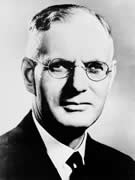
s.jpg)
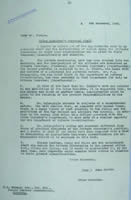
s.jpg)
s.jpg)
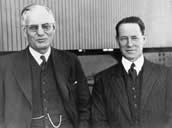
s.jpg)
s.jpg)
s.jpg)
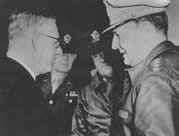
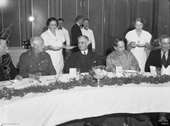
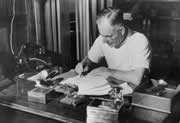
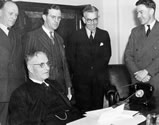
s.jpg)
s.jpg)